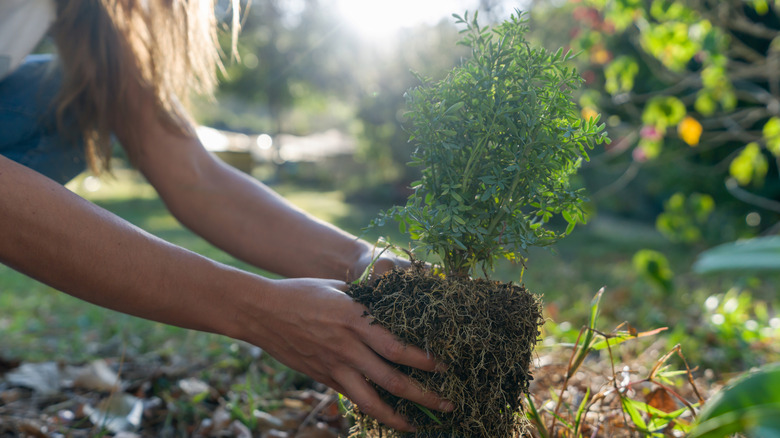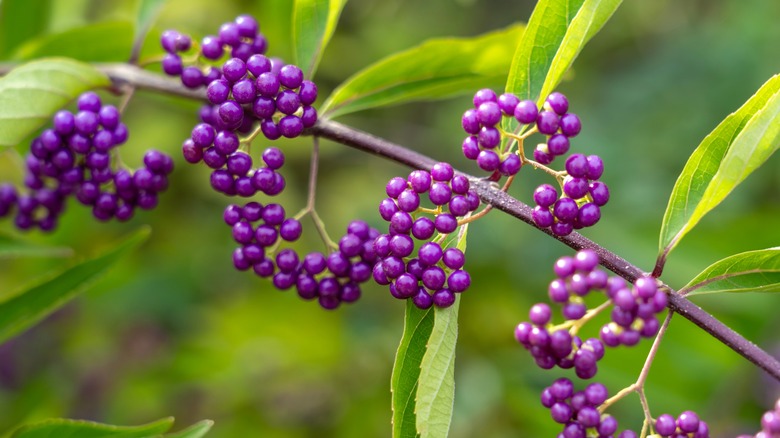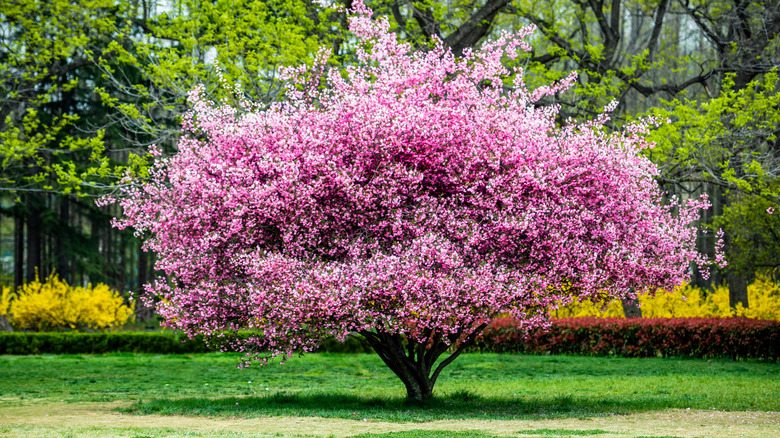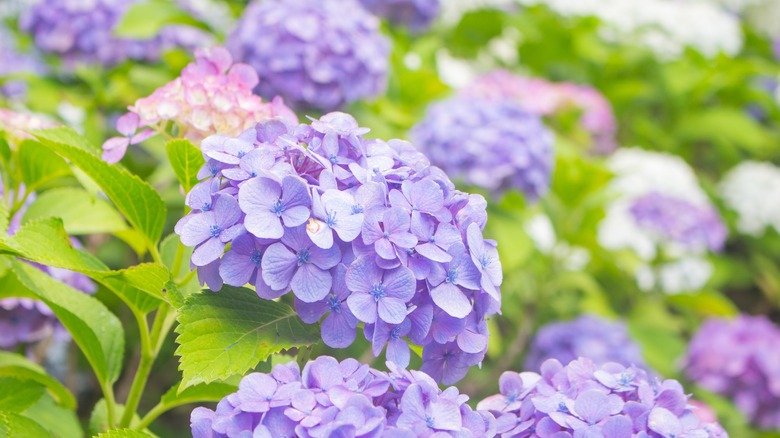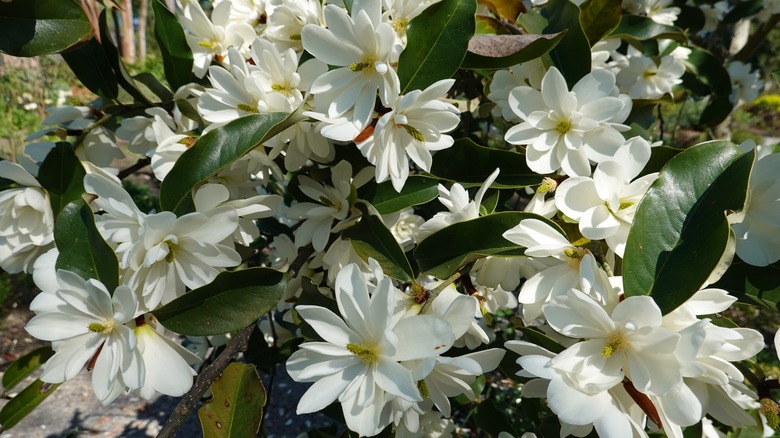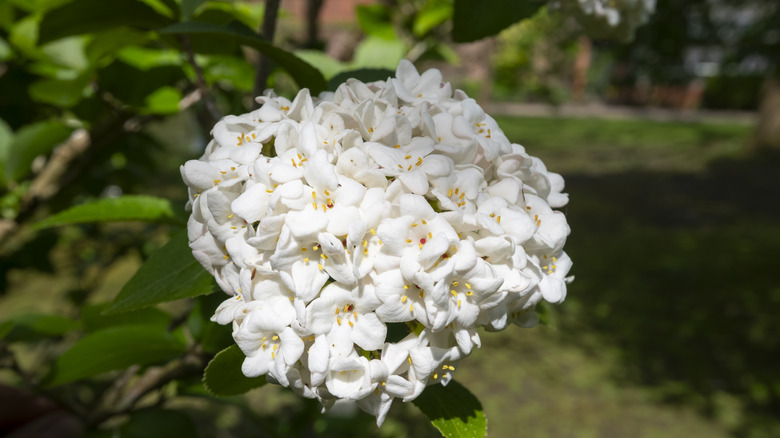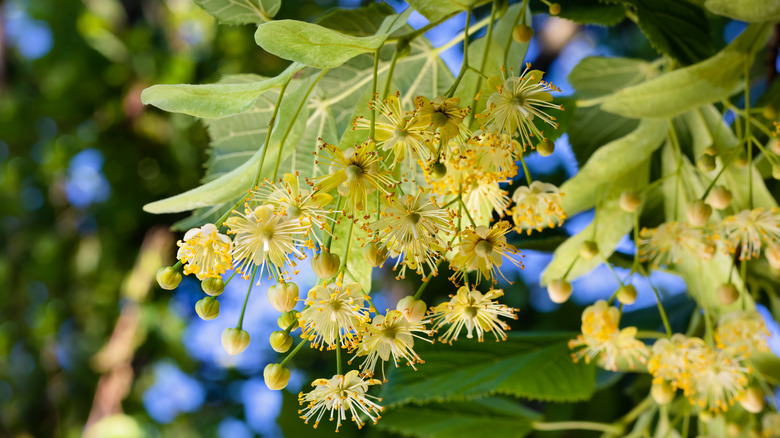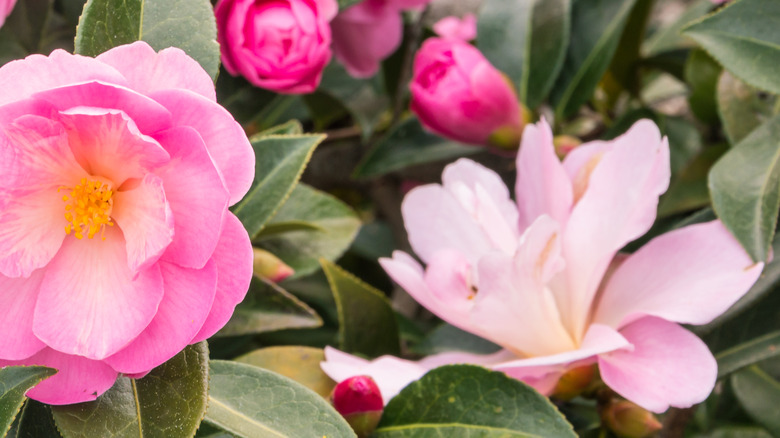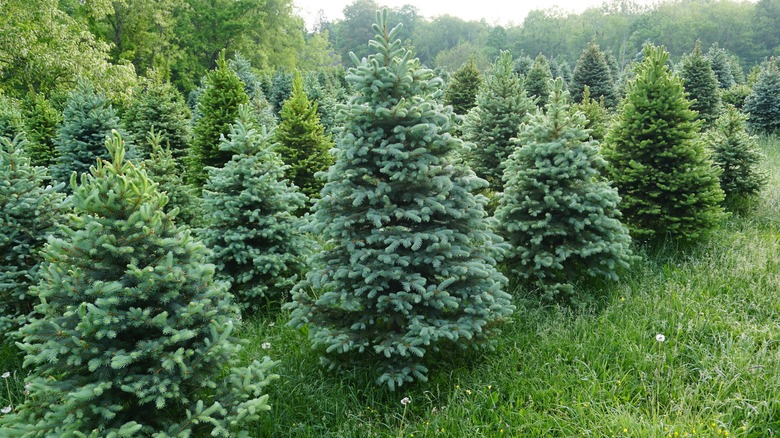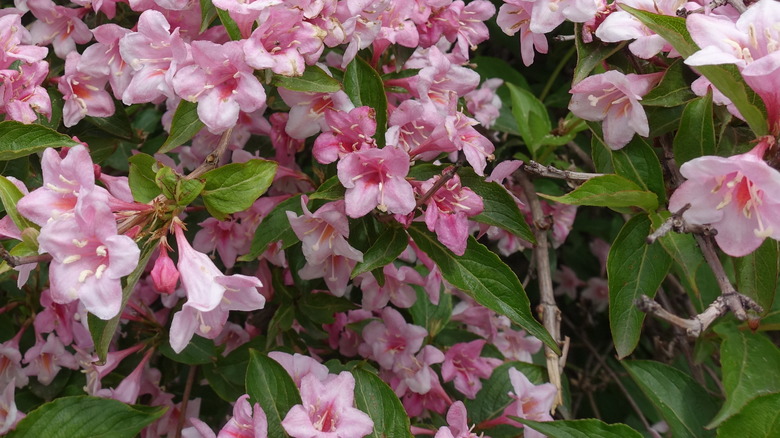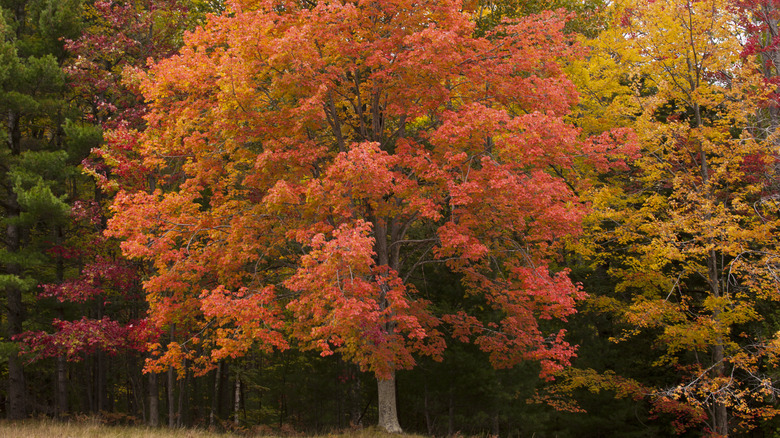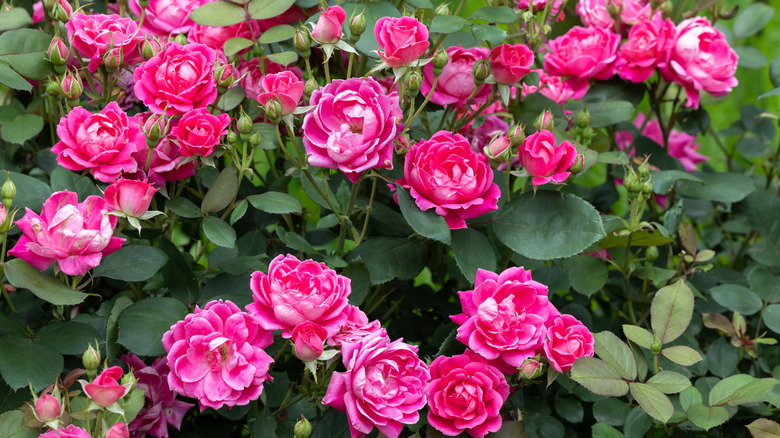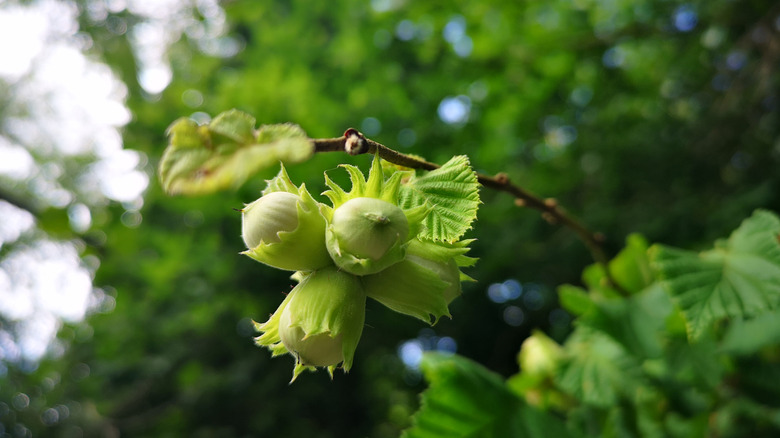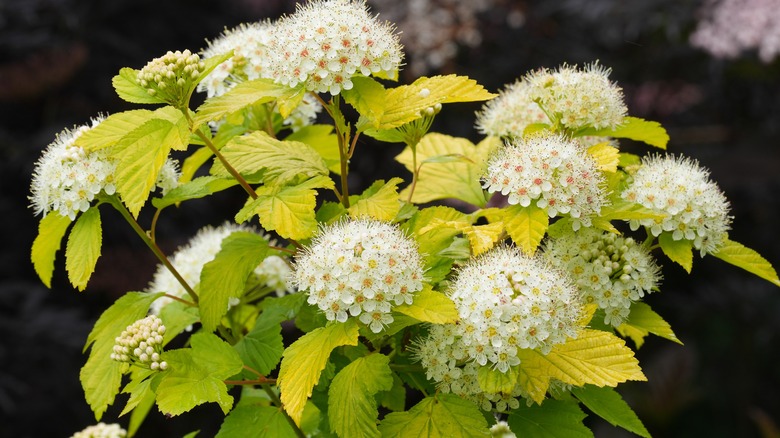13 Bushes And Trees You Can Plant During Dormant Season
Many gardeners plant perennials in the fall, as it's a great time to add some dormant plants to the garden. You can plant trees and shrubs, too, but since more digging and complex root systems are involved, there are some considerations to keep in mind. If you live in a warmer growing zone (USDA 6 or above), you are more likely to be able to dig without cold temperatures, making the soil too hard.
The first thing to do is watch the weather forecast and plant before the first hard frost date in your area, if possible. This will ensure the ground stays soft enough to dig, so the newly planted trees or shrubs won't be immediately hit with cold temperatures that may stress them too much. One night below freezing won't be too much, but try to avoid planting right before several overnight freezes in a row. You should also provide a layer of mulch for winter protection while the tree or shrub is getting established. Natural mulch such as shredded pine bark, wood chips, or pine straw are best.
There are many native and exotic trees and shrubs suitable for planting during the late autumn to early winter dormant season, including maples, spruce trees, and flowering specimens such as hydrangeas and magnolia trees. When choosing shrubs or trees to plant, make sure you check the growing specifications (sunlight, soil, etc.) and the mature size to choose the best location. You may even get a great bargain at your local nursery as they wind down the planting season.
Purple Beautyberry
Purple beautyberry (Callicarpa) is an easy-care deciduous shrub that produces gorgeous magenta-purple berries late in the season that attract songbirds like cardinals. The leaves turn yellow in autumn, adding to the dramatic show. It's often easy to find these in nurseries in autumn, given their late-season color. The beautyberry does well in partial to full sun and can get fairly tall (up to nine feet), but the size can be kept manageable with regular pruning. The best time to prune is in late winter before new spring growth begins.
Crabapple tree
While it's usually recommended to plant apple trees in early spring, one exception is the hardy, resilient crabapple (Malus). Fall is a good time to plant these naturalized apple trees, the closest we have to a native apple tree in North America. They take several years to get established, but then you get a lovely fragrant show of spring petals every year and tiny fruits in the fall for making jelly (or for feeding birds and wildlife). There are a few different cultivars, from 10 to 20 feet tall, with blossom colors ranging from white to dark pink.
Hydrangea
Hydrangeas begin to go dormant around mid-October in colder zones, which is also a good time to plant them. Nurseries sell hydrangeas all season long, so you may get a bargain in the fall when price reductions happen. Most broadleaf pink or blue hydrangeas (like 'Nikko Blue') are less cold-hardy than white ones (Hydrangea paniculata). They do best in USDA zones 6 to 9, but in zone 5, they may thrive with winter protection, so plant them where they'll get plenty of winter sunshine and be sheltered from cold winds, and top them with natural mulch for protection.
Sweetbay magnolia
The sweetbay magnolia (Magnolia virginiana) is a beautiful medium-sized flowering tree that thrives in damp soil. In warmer zones, the glossy dark green leaves may remain evergreen, but in USDA zones 6 and below, it will drop its leaves in winter. The fragrant flowers of this tree are loved by many insect and bird pollinators. Although this tree is hardy, it may need winter protection in areas with windy winter conditions. In times of drought, this tree may need supplemental watering.
Viburnum
The Korean spice viburnum (Viburnum carlesii) is probably the most popular viburnum. In spring, it produces round clusters of creamy pink and white blossoms with a heavenly fragrance. It's cold hardy to zone 4, easy to care for, and suitable for planting in the fall when its active growth cycle is dormant. There are a few different cultivars, including some dwarf-sized ones and others that grow up to ten feet tall. These attractive shrubs do well in partial sun and like slightly acidic soil.
Linden tree
The linden (Tilia americana) is a sturdy tree, also known as basswood, and bears delightfully fragrant flowers in late summer. The scent is delicious, a citrusy, floral perfume that attracts insects to its nectar-filled blossoms. Linden trees can grow quite tall, so you'll want to make sure you have space for the large canopy of this tree at its mature size (up to 90 feet). The wood is fairly soft, allowing the tree to gracefully withstand tough winter weather in the Northeast USA.
Camellia
Camellia blooms have been compared to peonies and roses, a comparison inspired by their vivid colors and delicate layered petals. Camellia japonica is hardy in USDA zones 7 to 9 and may bloom into the winter months with the proper care. There is a red flowering cultivar called "Yuletide" that blooms in December. Camellia oleifera (tea oil camellia) can be cold hardy in zone 6 with winter protection. Add a layer of natural mulch (like pine straw) over the roots before the first frost date, and be sure to plant in a spot sheltered from winter wind in rich, well-drained soil.
Spruce tree
There are a few different varieties of spruce trees, but the blue spruce (Picea pungens), also known as Colorado blue spruce, is by far the most popular. Unlike its cousin, the Norway spruce (Picea abies), which grows fast and can be somewhat invasive, the blue spruce is slow-growing and manageable. It doesn't need pruning, although you may want to trim it slightly to make the branches more dense. Deer leave this tree alone, and its brilliant blue-green color stays gorgeous all year round. In heavy snowstorms, be sure to shake excess snow from the limbs to prevent breakage.
Weigela
This deciduous flowering shrub requires no special care other than regular pruning to help it keep a pleasing shape. The weigela is covered with masses of trumpet-shaped pink blooms in late spring to early summer, attracting pollinators, including hummingbirds. You can do renewal pruning every few years to control its size, and this should be done after the flowering cycle ends in late summer. This cold hardy shrub can be planted either in early spring or late fall. Give it plenty of sunlight, a bit of space to branch out to mature size and well-draining soil.
Maple tree
There are many varieties of maple trees (Acer), and all of them are cold hardy, sturdy, long-lived, and with stunning autumn foliage. They're great for shade, provide shelter for wildlife, and are drought-tolerant, also. Many maple tree varieties tend to have shallow roots and need to be planted where the roots won't interfere with sidewalks or foundations. Some of the most commonly grown maples include sugar maple, red maple, and silver maple. Check the mature size before choosing one, and make sure it will have plenty of space to grow to its full size.
'Knockout' roses
Shakespeare wrote, "Of all flowers, methinks a rose is best," and indeed, it seems no garden is complete without roses. There are countless varieties, with some requiring more care than others. 'Knockout' roses are a newer hybrid: hardy, easy-care plants that bloom for many weeks. There are single and double-petaled plants in a range of colors. They do need frequent deadheading to keep the blooms coming. 'Knockout' roses can be planted in fall in a sunny spot with well-drained soil. Once established, they grow vigorously and can be pruned back in late autumn to encourage new canes.
Hazelnut tree
The hazelnut tree has declined in popularity somewhat among American gardeners in recent years. This beautiful understory tree stays fairly small and produces delicious nuts loved by people and wildlife. The hazelnut (or filbert) also has rich folklore associated with Celtic mythology and symbolizes wisdom and knowledge. You must plant at least two trees for proper pollination and nut production. The American hazelnut tree (Corylus americana) is hardy to USDA zone 4b and can be planted in late fall. Give the trees some natural mulch over the roots the first several winters until they get established.
Ninebark
The ninebark (Physocarpus opulifolius) has three seasons of visual interest, making it an increasingly popular landscape shrub. It has shapely leaves that shift colors throughout the season and attractive clusters of white flowers in summer; some varieties have particularly colorful leaves of purple or orange. This fast-growing native shrub can grow quite large and benefits from occasional renewal pruning, but some newer dwarf cultivars fit smaller spaces. Given the ninebark's excellent cold hardy nature, planting it in the fall will give it a good start. Top the planting with some natural mulch.
